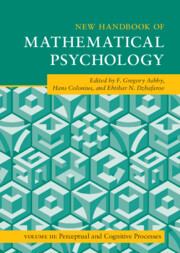Book contents
- Frontmatter
- Contents
- Contributors
- Preface
- 1 Principles and Consequences of the Initial Visual Encoding
- 2 Measuring Multisensory Integration in Selected Paradigms
- 3 Fechnerian Scaling: Dissimilarity Cumulation Theory
- 4 Mathematical Models of Human Learning
- 5 Formal Models of Memory Based on Temporally-Varying Representations
- 6 Statistical Decision Theory
- 7 Modeling Response Inhibition in the Stop-Signal Task
- 8 Approximate Bayesian Computation
- 9 Cognitive Diagnosis Models
- 10 Encoding Models in Neuroimaging
- Index
10 - Encoding Models in Neuroimaging
Published online by Cambridge University Press: 20 April 2023
- Frontmatter
- Contents
- Contributors
- Preface
- 1 Principles and Consequences of the Initial Visual Encoding
- 2 Measuring Multisensory Integration in Selected Paradigms
- 3 Fechnerian Scaling: Dissimilarity Cumulation Theory
- 4 Mathematical Models of Human Learning
- 5 Formal Models of Memory Based on Temporally-Varying Representations
- 6 Statistical Decision Theory
- 7 Modeling Response Inhibition in the Stop-Signal Task
- 8 Approximate Bayesian Computation
- 9 Cognitive Diagnosis Models
- 10 Encoding Models in Neuroimaging
- Index
Summary
Encoding models of neuroimaging data combine assumptions about underlying neural processes with knowledge of the task and the type of neuroimaging technique being used to produce equations that predict values of the dependent variable that is measured at each recording site (e.g., the fMRI BOLD response). Voxel-based encoding models include an encoding model that predicts how every hypothesized neural population responds to each stimulus, and a measurement model that first transforms neural population responses into aggregate neural activity and then into values of the dependent variable being measured. Encoding models can be inverted to produce decoding schemes that use the observed data to make predictions about what stimulus was presented on each trial, thereby allowing unique tests of a mathematical model. Representational similarity analysis is a multivariate method that provides unique tests of a model by comparing its predicted similarity structures to similarity structures extracted from neuroimaging data. Model-based fMRI is a set of methods that were developed to test the validity of purely behavioral computational models against fMRI data. Collectively, encoding methods provide useful and powerful new tests of models – even purely cognitive models – that would have been considered fantasy just a few decades ago.
- Type
- Chapter
- Information
- New Handbook of Mathematical Psychology , pp. 421 - 472Publisher: Cambridge University PressPrint publication year: 2023



